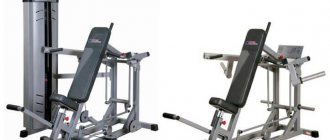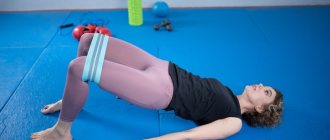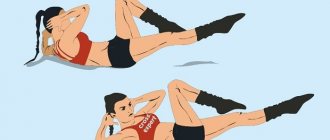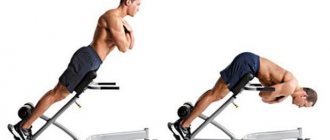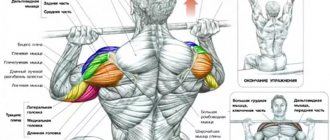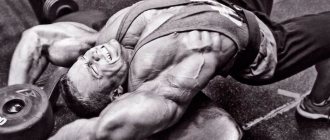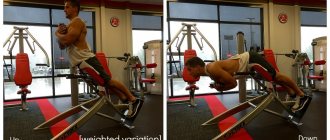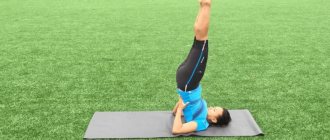Hyperextension is the most favorite exercise of many in the gym. Even among beginners, it is especially popular precisely because of the apparent simplicity of the technique at first glance: “What’s the difficulty? He bent over and straightened up.”
There are several important details that are often overlooked. In this article we will carefully look at each of them, as well as the most common mistakes and different options for performing this exercise so that simple flexion-extension turns into an effective exercise for strengthening and working the muscles of the back, hamstrings and buttocks.
Hyperextension is a multi-joint exercise that targets the spinal extensors, hamstrings (biceps and semitendinosus) and gluteal muscles. It is performed both as a separate exercise and as a finishing exercise after performing more “heavy” multi-joint exercises: deadlifts, bent-over barbell rows and barbell squats. Some people practice it as a warm-up before deadlifts or squats, but this method is not particularly popular, as it “clogs” the lower back and makes the following exercises more difficult to perform.
Hyperextension: what is the essence of the exercise?
Hyperextension is a popular exercise performed in the gym. “In the literal sense, the term “hyperextension” means “extension,” or more precisely, “hyperextension,” so the exercise that we are used to doing in the gym, from a terminological point of view, is more correctly called “extension,” explains Yulia Malenchuk, an expert in group programs. X – Fit in Russia.
It is a mistake to think that hyperextension is “intended” to work only the back muscles. “Hyperextension is a pelvic-dominant exercise. The spinal extensors work statically, the hip extensors give dynamics to the movement,” Sergei Artyushenko, coach of the ArtFitness club, makes things clear.
However, the back muscles, buttocks, and the muscles of the back of the thighs receive part of the load here.
“The following muscle groups are involved in this movement: quadratus dorsi (extensor), biceps femoris (biceps femoris), semitendinosus femoris, semimembranosus femoris, gastrocnemius and gluteus maximus,” says Nikita Kusakin, coach of the ArtFitness club.
What to replace
There are many variations of exercises that can be performed instead of hyperextension. The simplest option is the gluteal bridge. When doing this exercise, you need to transfer the entire load to the buttocks, while the lower back is simply fixed. The extensor muscles of the back will be included in the work, but indirectly.
It is also recommended to perform deadlifts. It will allow you to work your buttocks, hamstrings and back extensor muscles. In this case, weights are definitely needed. This could be a barbell, dumbbells, or simple water bottles. The back should remain straight. It is necessary to carefully monitor your posture. All movements must be smooth, as jerking can injure your lower back.
You need to start training with minimal weights.
Over time, it can begin to be increased.
An equally effective exercise is the pump. Lying on your back, you need to raise your arms and legs. In this case, the muscles work in a static position. The boat can be performed without weights. The main load goes to the lower back, the buttocks are used secondary.
What types of hyperextension are there?
Unlike other exercises (such as lunges), hyperextensions do not have the same abundance of options. The main variations of the movement are either training on the floor or in a special simulator. “The most appropriate and injury-safe option is in a special simulator (the shins are fixed in supports, the front surface of the thigh lies on the platform), where we perform flexion-extension in the hip joint with a fixed lower back,” says Yulia Malenchuk. — This variation is aimed at training the extensor muscles of the hip joint: the gluteal muscles, the muscles of the back of the thigh, the adductor muscles (they work here in a dynamic mode, that is, they lengthen and relax when lowering the body and contract when lifting), as well as the extensor muscles of the vertebral column column (they work statically, maintaining a neutral position of the lower back, that is, their direct function is trained, which these muscles must perform in life).
It is also permissible to replace this exercise with an alternative one. “The movement closest to this one in terms of biomechanics is the Romanian deadlift or straight-legged deadlift,” says Yulia Malenchuk. — Essentially, the same movement is performed (flexion-extension of the hip joint) and the same muscles are trained. However, this movement will be technically more complex, since the body is not fixed in the simulator, and it is necessary to control its work in space.”
What muscles work
To evaluate the benefits of back extension on a bench, you need to take a closer look at which muscle groups are involved in this exercise:
- Straightening the spine. It is the target muscle that is the main focus during hyperextension. It is used both when extending the back at a right angle (90 degrees) until it is parallel to the floor surface, and when straightening the body at an acute angle (45 degrees). The muscle responsible for straightening the spine is a group of bundles that articulate with the pelvis, ribs, and spine. They are located along the entire length of the spine. Their strengthening has a beneficial effect on posture and the correct curves of the spinal region.
- Hip Extenders. Includes the buttocks and muscles located on the back of the thighs. They, like the straightening muscle, are involved when performing any version of hyperextension. The hip extensors, like the core muscles, begin to weaken if not given proper attention. This is true not only for those people who do not lead an active lifestyle. Often, even during training, they are little involved. Thanks to hyperextension, they regain their tone.
- Neck extensions. These extensors are small and located at the back of the neck. They are responsible for the mobility of the cervical spine. These muscles definitely need to be strengthened. This is especially true for people who spend a lot of time at the computer. They awaken and are activated when hands are placed on the head or neck, performing hyperextension. This option is considered more complicated.
The effectiveness of back extension on a bench is beyond doubt. The main thing is to know how to do this exercise correctly.
Hyperextensions - Technique. 7 variations.
Hyperextension: basic mistakes
This exercise is often performed with errors, disrupting the biomechanics of movement. “Unfortunately, in most cases, hyperextension is performed somewhat incorrectly,” says Alexey Bolyaev, personal trainer at the Women Secrets women’s fitness studio in Tsaritsyno . “And in the way I often see it, there is more harm than good.”
We have compiled a list of the main mistakes that are made when performing hyperextension. These include:
Hyperextension of the lower back. “In this case, the vertebrae can compress the intervertebral discs, which often leads to protrusions and hernias,” adds Alexey Bolyaev.
Incorrect neck position. “Often it is also hyperextended during the exercise; normally, the neck should be simply an extension of the spine,” reminds Nikita Kusakin.
Incorrect “setting” of the simulator. “If you place the machine bench too high or too low, you will disrupt the biomechanics of the movement. Watch this,” warns Nikita Kusakin.
What you should pay attention to? “When working in the simulator, it is important to set it up correctly: the hip supports should end just below the hip joint so as not to interfere with the lowering of the body,” advises Yulia Malenchuk.
Excessive weight of burdens. It is permissible to perform hyperextension by picking up a dumbbell or a barbell disc. But you should not take equipment that is too heavy, this will disrupt the execution technique.
Knee bending. When performing exercises in the simulator, watch the position of your legs: do not bend your knees, as this will “shift” the load from the target muscles.
Technique for performing hyperextension
Hyperextension is done as follows:
- They lie face down on the bench, and their legs in the shin area are fixed on special platforms.
- The body is straightened, crossing the arms in front of the chest, thereby taking the starting position.
- Keep your back straight and exhale, slowly lowering yourself down to the maximum possible.
- The lowering of the body should be accompanied by inhalation of air, so that both the lower dorsal and biceps femoral muscles are stretched.
- They begin to rise up, exhaling. You should clearly feel how all the muscle groups targeted by the exercise contract.
This order of actions is maintained in each repetition.
Important Tips
To get the maximum benefit from the exercise, you need to consider several important nuances:
- It is not recommended to lower the housings below a comfortable level. The hips and back should stretch, but without any obvious feeling of discomfort.
- Straightening, like lowering, should not bring unpleasant feelings to the back area.
- Hyperextension can be made more difficult by stretching your arms, holding a load in your hands in front of your chest, or by performing the exercise with one leg.
- You should not try to lift too much weight. If you do not calculate your own strength, this exercise for stretching muscle groups will become traumatic.
If there is no special bench, you can use a regular one.
Important!
There are three different variations of hyperextension, which are often confused with each other. Back extension is an option in which movement is carried out exclusively in the lumbar and dorsal region, and the thigh muscles remain motionless. Hipaxtensia is the opposite of the previous type, since movement occurs at the hip joint, and the lower back is motionless. During hyperextension, both the lumbar and hip muscles work.
How to perform hyperextension correctly
To avoid these mistakes, learn the correct technique for performing hyperextension.
So, fix your body position in the simulator. “You can cross your arms over your chest, or take a weight (an option for those who are prepared!). As you inhale, smoothly lower down, keeping your lower back in a neutral position, you should feel a stretch in the muscles of the back of the thigh, as you exhale, rise until the body and legs form a straight line, says Yulia Malenchuk. — When performing this exercise, it is important to monitor the parallelism of the feet (if one foot turns out more than the other, the load on the legs will be uneven), the smoothness of the movement (do not “fall down”, rise up smoothly, and not jerkily due to inertia), the work of the lower back (maintain a neutral position, no flexion-extension in the lumbar region) and range of motion (avoid hyperextension).”
How to avoid injury?
The lower back is considered the most vulnerable part of the body. It is most exposed to stress. Only twenty percent of adults can boast of a complete absence of pain in this area. This means that performing hyperextension requires maximum caution, since the main load, and, most importantly, the stretching, falls on the muscles in this part of the spine.
To avoid injury, you need to follow a few simple rules that apply not only to sports, but also to everyday life:
- It is necessary to lift heavy objects not with the efforts of the back, but with the legs. If you strain your back, you can easily injure it.
- Do hyperextension not occasionally, but regularly. The best thing, of course, is daily. This will strengthen the most vulnerable part of the body.
- Control your weight. Obesity negatively affects overall muscle tone, health and, of course, the back.
- Stretch your back muscles every day. This will avoid unnecessary tension in this area.
Nutrition is of great importance for the prevention of injuries in the lumbar region. Food should be rich in minerals and vitamins and not empty calories. In order not to have to struggle with excess weight, if there is such a predisposition, it makes sense to periodically arrange fasting days.
Is it possible to perform hyperextension if your back hurts?
Any painful sensations in the body are a reason to discuss them with your doctor. Especially when it comes to back discomfort. “Hyperextension is not an exercise for strengthening the back, especially if you have lower back pain. These symptoms are most often not associated with the condition of the muscular corset, but come from the incorrect position of the pelvis, warns Sergei Artyushenko. — It may, for example, happen that with lumbar hyperlordosis, performing hyperextension will only increase the pain. This is because hyperesthesia creates a torque in the spine.”
In such cases, it is better to replace the exercise with an alternative movement or perform it on a fitball.
Using additional weights during hyperextension
In hyperextension, additional weight is used to organize a progressive load aimed at increasing muscle volume. The use of additional weights also depends on when the exercise is performed. When using hyperextension as a warm-up, no additional weight is used. If hyperextension is the main exercise of the complex, additional weight is introduced after several days of training and achieving impeccable quality of the movements performed. The load is increased slowly and it is ensured that it does not exceed five kilograms.
Variants of the exercise “Hyperextension”
We asked Alexey Bolyaev to show us popular variations of the hyperextension exercise.
How to build a lesson
- Do a short joint warm-up.
- Use the exercises the way you like: choose 1-2 movements and include them in your training program. It is not worth performing the entire complex - the load is too intense.
- It is acceptable to perform hyperextension 2-3 times a week (in this mode you will have time for muscle recovery).
- Perform the exercise for 20 repetitions. If it’s difficult, less is possible.
To perform the complex you will need a mat and a hyperextension machine.
Classic hyperextension on the floor
1-hyperextension on the floor
Lie on your stomach, stretch your legs and rest the toes of your feet on the floor. Bend your arms at the elbows, point your palms towards your head. Gently lift your body above your body, actively working the muscles of your back and lower body. Don't strain your lower back. Then slowly lower yourself to the starting position. This is one repetition, do 20 of these.
Hyperextension with leg raise
2-hyperext with raising arms and legs
Lie on your stomach, stretch your legs and rest your toes on the floor. Stretch your arms in front of you. Working the muscles of your back, legs and abs, smoothly lift your arms and legs above the floor. Do not squeeze your lower back and neck (direct your gaze to the floor). Then slowly lower yourself to the starting position. This is one repetition, do 20 of these.
Hyperextension with scapula retraction
3-hyperext with hands together
Lie on your stomach, stretch your legs and rest your toes on the floor. Stretch your arms forward, pointing your palms slightly towards each other. Then lift your body off the floor, working the muscles of your back, buttocks and the back of your legs. Bring your shoulder blades together by bending your elbows and pointing them back. Do not squeeze your lower back, do not slouch, direct your gaze forward and down. This is one repetition, do 20 of these.
Hyperextension in the simulator
4-hyperext in the body lifting machine
Position your torso and lock your legs into the hyperextension machine. Place your hands on your chest. Lean your body forward, working the muscles of the buttocks, back and hamstrings. Then smoothly return to the starting position. Do not put pressure on your lower back or neck. This is one repetition, do 20 of these.
Hyperextension in a pelvic twisting machine
5-hyperext with pelvic twisting
Position your torso and lock your legs into the hyperextension machine. Place your hands on your chest. Slightly twist your pelvis forward. Lean your body forward, working the muscles of the buttocks, back and hamstrings. Return to the starting position, do not put pressure on your lower back and neck. This is one repetition, do 20 of these.
Hyperextension in the simulator with shoulder blade retraction
6 - hyperext with shoulder blades
Position your torso and lock your legs into the hyperextension machine. Bend your elbows, bring your shoulder blades together, place your palms near your ears. Lean your body forward, working the muscles of the buttocks, back and hamstrings. Return to the starting position, do not put pressure on your lower back and neck. This is one repetition, do 20 of these.
As you perform these exercises, monitor your sensations: if you feel discomfort in your back (especially in the lumbar region), stop the workout and check your technique again.
Content
- Step-by-step description of the classic technique
- How to properly perform hyperextension for the back?
- How to properly exercise on a hyperextension machine:
- Features of performing hyperextension on the buttocks and back
- Common mistakes in hyperextension technique
- Options for performing hyperextension Reverse hyperextension
- Hyperextension with weights
- Lateral hyperextension
The main load falls on the back extensor muscles - the long muscles along the spine, the gluteus maximus and the hamstrings. The exercise is suitable if you train at home, as it can be performed without special equipment.
General recommendations
Quantity and quality of execution
Don't chase a lot of repetitions, pay more attention to their quality. Perform movements smoothly, without jerking or swaying, using muscles, not inertia. On average, for all exercises this is 2-3 sets of 5-10 repetitions, in some cases you can do delays at the top point for 1-2 seconds.
As you adapt to the loads, you can strengthen it. This is done with the help of additional weight, which is taken in the hands or feet. It is important to listen to your own body, be careful, hyperextension is in some sense “insidious”. Initially there is no tension, but if you overdo it, then in the morning there will be pain in the lower back and tailbone.
Technique
Correct technique is an aspect no less important than the number of repetitions. To prevent compression of the intervertebral discs, it is not recommended to do the following:
- Round your back.
This is the most common mistake that beginners make. When rounding, the lower part of the core does not swing, which reduces the effectiveness of the exercise to zero. - Sudden movements.
The athlete must perform all actions slowly and in a controlled manner. Sharp jumps will not lead to anything good. Uncontrolled movement - risk of injury. - Excessive arching of the back
. You should not deviate too far; the person’s spine should not experience excessive tension and pain. - Work of the buttocks.
Make sure that your buttocks are tense, this makes arching in the lower back much safer.
